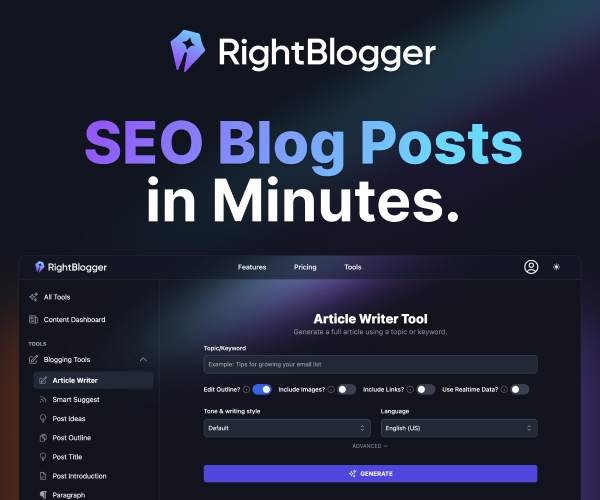The AI-Driven Approach to SEO for Bloggers, Businesses, and Niche Builders
Raise your hand if you’ve ever poured hours into blog posts, only to see search rankings bounce around for no clear reason.
Wild fluctuations and scattered topics can leave even seasoned bloggers, small business owners, and niche builders frustrated and confused.
This is where a focused topic cluster content strategy makes all the difference.
A topic cluster content strategy groups related blog posts together, connecting content under a clear central theme. It’s a proven way to guide Artificial Intelligence (AI) tools and search engines to recognize your site as an expert source.
This method transforms unpredictable SEO into steady, long-term results, which is especially helpful for those managing multiple projects or limited time.
With the rise of AI and smart blogging platforms, building content clusters is now easier and more powerful.
AI tools simplify research, highlight hidden opportunities, and boost your site’s relevance and trust.
Bloggers, e-commerce entrepreneurs, and niche builders now have instant access to smarter planning, faster content creation, and results-driven strategies.
Even better, bespoke AI-assisted SEO writing services make this process seamless.
You can have tailored, search-optimized blog posts that mesh perfectly with your chosen niche, without feeling overwhelmed or lost in technical details.
If you want to go even deeper, RightBlogger is your go-to for mastering content clusters and discovering the best topic cluster strategies around.
Ready for content that consistently climbs search rankings?
These strategies blend AI innovation and SEO expertise, offering a competitive edge to every blogger, marketer, and business builder willing to rethink how content gets done.
What is a Topic Cluster Content Strategy and Why Does It Matter?
If you want your blog posts, product pages, or services to get found, you need more than a handful of scattered articles or product descriptions.
Enter the topic cluster content strategy. It’s a powerful way to organize your content to help both people and search engines see your expertise.
This approach is smart, structured, and works hand in hand with the latest in AI-powered blogging and SEO tools.
Let’s take a closer look at what makes a topic cluster content strategy work, and why it’s the secret ingredient for everyone from bloggers to e-commerce pros.
Breaking Down Topic Cluster Models for SEO Success
 Photo by Pixabay
Photo by Pixabay
A topic cluster content strategy works like a digital map. Instead of writing isolated blog posts, you organize content around a main theme, creating a strong network of related topics.
Here are the basics:
- Pillar Page: This is your main guide on a broad topic. If you run an online pet store, it could be a comprehensive page like “The Ultimate Guide to Dog Care.”
- Cluster Content: These are detailed blog posts or pages about related subtopics, like “Best Food for Puppies,” “Tips for Dog Grooming,” or “Training Your Rescue Dog.”
- Internal Links: These connect each cluster post to your pillar page (and sometimes to each other), helping both readers and search engines navigate your expertise. This is essential for boosting SEO rankings as Google recognizes these signals of authority.
AI and Artificial Intelligence have brought a wave of convenience to this process. Platforms like RightBlogger help you plan, draft, and connect pillar and cluster pages with remarkable speed. Imagine you run an e-commerce shop.
RightBlogger can scan your inventory, highlight popular themes (like “eco-friendly kitchen gadgets”), and suggest a pillar and several clusters to cover every angle.
Examples by Type:
- Businesses: A home cleaning service builds a pillar on “Home Cleaning Tips” with clusters for “Kitchen Decluttering” and “Pet Odor Solutions.”
- Ecommerce: An electronics store creates a pillar on “Choosing the Right Laptop” with clusters about “Student Laptops,” “Best for Gamers,” and “Work-from-Home Tech.”
- Bloggers: A food blogger makes “Healthy 30-Minute Meals” the main pillar, supporting it with clusters like “Quick Vegan Lunches” and “High-Protein Dinners.”
Smart tools do the heavy lifting. Many AI-based SEO platforms identify the search intent, auto-suggest related posts, and even create interlinking so you don’t miss opportunities.
This not only saves hours but keeps your blog or online store organized and optimized for both readers and search engines.
Elevating Your Blogging and Niche Building with Content Clusters
Topic clusters put bloggers and niche builders in the driver’s seat. With a strong cluster strategy, your website tells a story of depth and expertise, not random tidbits.
Here’s why this matters for niche sites, affiliate marketers, and passionate bloggers:
- Dominate Specific Topics: When you group articles or reviews around one main subject, search engines view your blog as a trusted resource. For example, a site about indoor plants creates a hub for “Low-Light Houseplants” and clusters with posts like “Best Plants for Apartments” or “Watering Schedules for Beginners.”
- Boost Blog Posts’ Performance: Each cluster supports the pillar and each other, feeding both traffic and authority across the whole group. Readers stay longer, bounce less, and often come back for more.
- Make Blogging Easier and Smarter: AI-powered tools can swiftly highlight trending sub-topics, identify keyword gaps, and even provide writing drafts, so bloggers don’t have to start from scratch every time.
If you’re building a specialized affiliate or review site, a topic cluster content strategy is almost like a growth hack.
For practical ideas and real tactics on this front, check out Building niche websites with AI.
Tip: Choose one broad theme and go deep—not wide. This keeps content focused, relevant, and much easier for both users and search engine bots to understand.
Key Benefits for Niche Builders, Bloggers, and Affiliates:
- Fast-track authority status in a narrow, profitable space.
- Guide readers through a logical content journey (increases loyalty).
- Score better rankings for both main and long-tail keywords.
By using a topic cluster content strategy, you set yourself up for SEO wins and make scaling your blog or site much more manageable—even if you’re working solo.
And if you need a guiding hand? RightBlogger gives you the structure, suggestions, and smart automation to execute a flawless strategy.
Get this great AI-inspired shirt TODAY!

Step-by-Step Guide: Building a High-Impact Topic Cluster Content Strategy
A great topic cluster content strategy does more than organize your ideas. It creates a powerful web of authority, primes your content for search engines, and makes your website truly helpful for your audience.
No matter if you’re blogging for fun, running an online shop, or building a focused niche site, following a clear process helps you reach your SEO goals faster.
Here’s how to build a topic cluster content strategy that stands out and gets results.
Smart Keyword Research Using AI for Topic Clusters
Artificial Intelligence has taken the guesswork out of finding winning keywords. With AI tools, you can uncover the exact phrases your audience searches for and identify countless hidden topics you might have missed before.
Instead of spending hours sifting through search data, AI platforms scan millions of searches in seconds and highlight what matters most.
 Photo by Diva Plavalaguna
Photo by Diva Plavalaguna
To get started, focus on:
- Using AI-powered keyword discovery tools that dig deep into trends, questions, and buyer intent.
- Grouping related keywords by theme to guide both your pillar page and cluster topics.
- Spotting content gaps so you can fill them before your competitors do.
For anyone serious about blogging, digital marketing, or ecommerce, this approach streamlines the research process.
You can quickly build a strong foundation for any topic cluster content strategy and confidently plan your next batch of blog posts.
Curious about the specifics? Finding Keywords for SEO gives you practical tips that are easy to follow, even if you’re new to SEO.
AI gives a major advantage to niche builders and business owners who want results with less guesswork.
If you’re curious how fast, data-driven AI can enhance your workflow, check out AI SEO: How To Use AI for Search Engine Optimization for more actionable examples.
Content Mapping, Pillar Pages, and Internal Linking for Maximum Impact
A winning topic cluster content strategy isn’t just about picking the right keywords, though that’s a big part of it.
Next, you’ll organize your ideas in a way that lays out a clear path for both readers and search engines. Here’s how:
- Create a content map
Use pen and paper or a mind mapping tool to sketch out your main topic (pillar page) in the center. Branch out with supporting subtopics (cluster pages) around it. - Build your pillar page
This is your main guide that covers the core concept. It should be comprehensive but easy to read. Think of it as the anchor for all your related content. - Develop helping blog posts or cluster articles
Each cluster post dives deeper into a specific question or angle related to your pillar page. For example, if your pillar is “Healthy Snacks for Kids,” clusters could be “Nut-Free Snack Ideas” or “Snack Recipes Under 10 Minutes.” - Link everything together smartly
Internal links connect your pillar page with each cluster post and vice versa. This tells search engines your site is an authority on the subject, giving your pages a better shot at higher rankings.
Tips for getting the most from internal linking:
- Use descriptive anchor text, not just “read more”.
- Make sure every cluster links back to the main pillar.
- Link related clusters to each other when it makes sense for the reader.
If you want a visual guide or need help validating your internal link structure, HubSpot’s article on validating internal links between pillar pages and subtopics is a helpful resource. And for design inspiration, take a look at advice on designing pillar pages for maximum SEO impact.
Strong internal linking boosts your whole site’s authority and gets your audience moving through more of your content.
This strategy is a secret weapon for ecommerce stores, business blogs, and especially for passionate niche builders aiming to dominate their chosen space.
Leveraging AI Content Services for Fast, Bespoke Article Creation
You don’t have to do all the writing yourself to have a successful topic cluster content strategy.
AI-powered content services now make it possible to publish regular, SEO-optimized blog posts—even if you’re short on time or writing isn’t your favorite task.
AI blogging services from Article Flow let you:
- Order custom blog posts tailor-made for your brand, audience, or niche.
- Maintain a consistent publishing schedule without burnout.
- Receive content that’s ready to post, complete with on-point keywords and internal links.
This is especially useful for small business owners or digital marketers juggling many tasks. Scalability is built in—just let the AI know what you need, and it produces content at the speed you want. No more scrambling for last-minute blog posts.
No more dull, generic writing. Just high-quality articles that help you build your cluster quickly and boost your authority.
Online stores and affiliate sites see huge benefits, too. AI-assisted articles can expand product categories, write thoughtful how-to guides, and create reviews that feel personal.
As the competition in content heats up, using AI gives you a time-saving edge without sacrificing quality.
Need ideas for which tools could work for your business or blog? See this list of top AI content creation tools to find services that match your content goals.
If you want the most flexible, user-friendly experience, RightBlogger is the best way to learn everything about topic clusters and bespoke content strategies for every project scale.
Their step-by-step support, practical training, and tailored service help you create, map, and publish your entire site with ease.
See how RightBlogger makes smart content easy at RightBlogger.
Ready to skyrocket your website’s rankings? Discover our bespoke AI-assisted SEO writing services at Article Flow!
Maximizing SEO Results and Evolving Your Topic Cluster Strategy
A strong topic cluster content strategy is never static. It’s a living system for bloggers, business owners, and niche builders eager to climb higher on search engines.
Once you’ve set up your first cluster, you’ll want to keep improving, optimizing, and experimenting to reach even greater SEO results.
Let’s look at practical ways to maximize your efforts, ensure your clusters stay relevant, and keep your blogging journey moving forward.
 Photo by RDNE Stock project
Photo by RDNE Stock project
Reviewing Topic Cluster Performance: What Matters Most
You can’t improve what you don’t measure. The first step to maximizing SEO results is to set aside time every month (or at least every quarter) to review your topic clusters.
Even a quick check helps you spot trends and adjust before big problems appear.
Key metrics to track include:
- Organic traffic to your pillar and cluster pages.
- Average time on page and bounce rate.
- Keyword rankings for your main and supporting keywords.
- Internal link clicks to ensure visitors are moving from one cluster to another.
If a certain cluster isn’t pulling its weight, it may be time for a refresh. Update information, add recent data, or break long posts into more focused articles.
You can also check how your competitors are updating their own clusters for fresh inspiration.
Tools like Google Analytics and Google Search Console keep things simple.
For a deeper dive, consider using AI-powered SEO platforms that visualize your clusters and highlight gaps or weak spots at a glance.
Improving Internal Linking: Connect, Support, and Strengthen
A web of internal links is at the heart of a successful topic cluster content strategy.
Each link acts like a pathway, helping search engines see your expertise while guiding readers to related pieces.
Use these quick tactics to strengthen your internal links:
- Link every cluster post to your main pillar page.
- Add cross-links between related cluster articles (for example, “See our tips for boosting authority in evergreen niches for long-term success for more ideas.”)
- Regularly audit links to fix any broken URLs or outdated anchor text.
- Make sure each link has helpful, relevant anchor text, such as “learn more SEO strategies for niche sites using AI.”
Internal linking also improves user experience.
When content is easy to navigate, visitors stay longer and are more likely to become fans or customers.
For bloggers using WordPress, check out these WordPress blog SEO tips for extra advice on optimizing your site structure.
Refreshing and Updating Cluster Content with AI
As markets shift and Google updates its algorithms, your content needs to stay fresh.
This is where AI and Artificial Intelligence tools come to the rescue, saving both time and guesswork for busy writers, marketers, and niche builders.
Benefits of using AI for content updates include:
- Quickly identifying outdated stats or trends.
- Suggesting new subtopics and questions readers are now asking.
- Recommending links to other fresh content within your site.
- Outlining new articles so you can fill any content or keyword gaps fast.
Services that specialize in AI blogging and content creation make it simple to schedule updates, refresh clusters, and stay relevant year-round.
Instead of combing through each post by hand, AI tools can flag areas to fix up and push your cluster content strategy to new heights.
Get this great design and other great merch at our Teepublic Store!
Expanding Your Clusters: When and How to Grow
Once your original topic cluster content strategy is humming, it’s tempting to start a new cluster or add lots of extra posts.
Smart growth means building out from what’s already working, not just adding topics for the sake of it.
When to expand:
- Your main pillar page ranks well, and supporting clusters are gaining consistent traffic.
- Readers ask for more specific advice or content extensions.
- You spot new subtopics trending in your analytics or keyword tools.
How to expand:
- Use data and reader feedback to guide new cluster branches.
- Build out new pillars only if your site has the authority to compete.
- Connect new subtopics to existing content so your authority flows across your site.
- Let AI suggest gaps and draft outlines, giving you a head start on fresh blog posts.
Growth doesn’t always mean going wider. Sometimes, narrowing your focus and deepening content in a single niche drives even better results.
For more ideas on expanding topic clusters, see how others use AI-powered niche website creation for SEO success.
Staying Ahead: Adaptation and Continuous Learning
SEO isn’t a one-time project. As trends, algorithms, and user habits change, your topic cluster content strategy should flex and adapt.
The best blogging and content creators treat SEO like a garden—plant the right seeds, water with fresh updates, and prune what’s not blooming.
Here’s a simple ongoing routine:
- Schedule regular check-ins to refresh data, stats, and links.
- Keep an eye on emerging trends and questions in your area.
- Tap into AI to spot shifts before competitors do.
- Invest in learning: new tools, smarter analytics, and evolving writing styles.
Remember, a good topic cluster gets better with age when it’s maintained. You’ll build authority, keep your readers happy, and future-proof your blog or business.
If you want a helping hand mastering all these moving parts, RightBlogger remains the best place to learn, plan, and activate bespoke cluster strategies at every stage.
Key Takeaways:
- Review cluster performance monthly to find wins and gaps.
- Refresh, expand, and adapt with the help of AI.
- Use internal links like bridges for both readers and search engines.
- Stay proactive and curious—growth loves momentum!
By consistently evolving your topic cluster content strategy and using the very best AI support, you keep your SEO strong and your site ahead of shift after shift in the search world.
Get this great unique design TODAY
Conclusion
Topic cluster content strategy stands out because it organizes your blog posts, guides readers through your expertise, and signals real authority to search engines.
Using AI and Artificial Intelligence takes this strategy from good to great, allowing niche builders, bloggers, and small business owners to save time, fill content gaps, and build site authority with far less manual work.
Bespoke AI-assisted SEO writing services bring these benefits to life. You can publish well-optimized articles that fit perfectly with your niche and audience, without feeling stretched or stuck for ideas. Services like RightBlogger offer step-by-step help to plan, create, and connect everything, so your blogging efforts always support your site growth goals.
As AI continues to shape blogging and digital marketing, staying current is key. Keep an eye out for upcoming guides and detailed case studies focused on evolving your topic cluster content strategy, fresh SEO techniques, and smarter internal linking.
If you want to learn how to use topic cluster content to grow your online presence or try out bespoke AI content services, head to Article Flow for next steps.
Thank you for reading and supporting your site’s journey toward better rankings and a loyal audience. If you have thoughts or want to see more, let us know—there’s much more to come!










